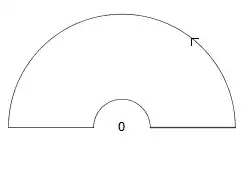Integrate $$f(z)=\frac{1-e^{iz}}{z^2}$$ over the contour $\gamma$ shown below.

where the circles are centered at $0$, line segments lie on the real line, the small circle has radius $r$, the large circle has radius $R$. We consider the limiting case when $R\to+\infty, r\to 0$.
Contribution of the small circle is
$$
-\pi i\,\text{Res}(f,0)=-\pi i(-i)=-\pi
$$
On the large circle we have
$$
|f(z)|=O(R^{-2})\implies \Big{|}\int_{\text{large circle}}f(z)dz\Big{|}=O(R^{-1})\implies\lim_{R\to\infty}\int_{\text{large circle}}f(z)\,dz=0
$$
Contribution of the real line is
$$
\text{p.v. }\int_{-\infty}^\infty\frac{1-e^{ix}}{x^2}\,dx
$$
By residue theorem
$$
\text{p.v. }\int_{-\infty}^\infty\frac{1-e^{ix}}{x^2}\,dx-\pi=0
$$
Equating real parts we see
$$
\text{p.v. }\int_{-\infty}^\infty\frac{1-\cos x}{x^2}\,dx=\pi
$$
Noting that the integrand is an even function we see
$$
\text{p.v. }\int_{0}^\infty\frac{1-\cos x}{x^2}\,dx=\frac{\pi}{2}
$$
